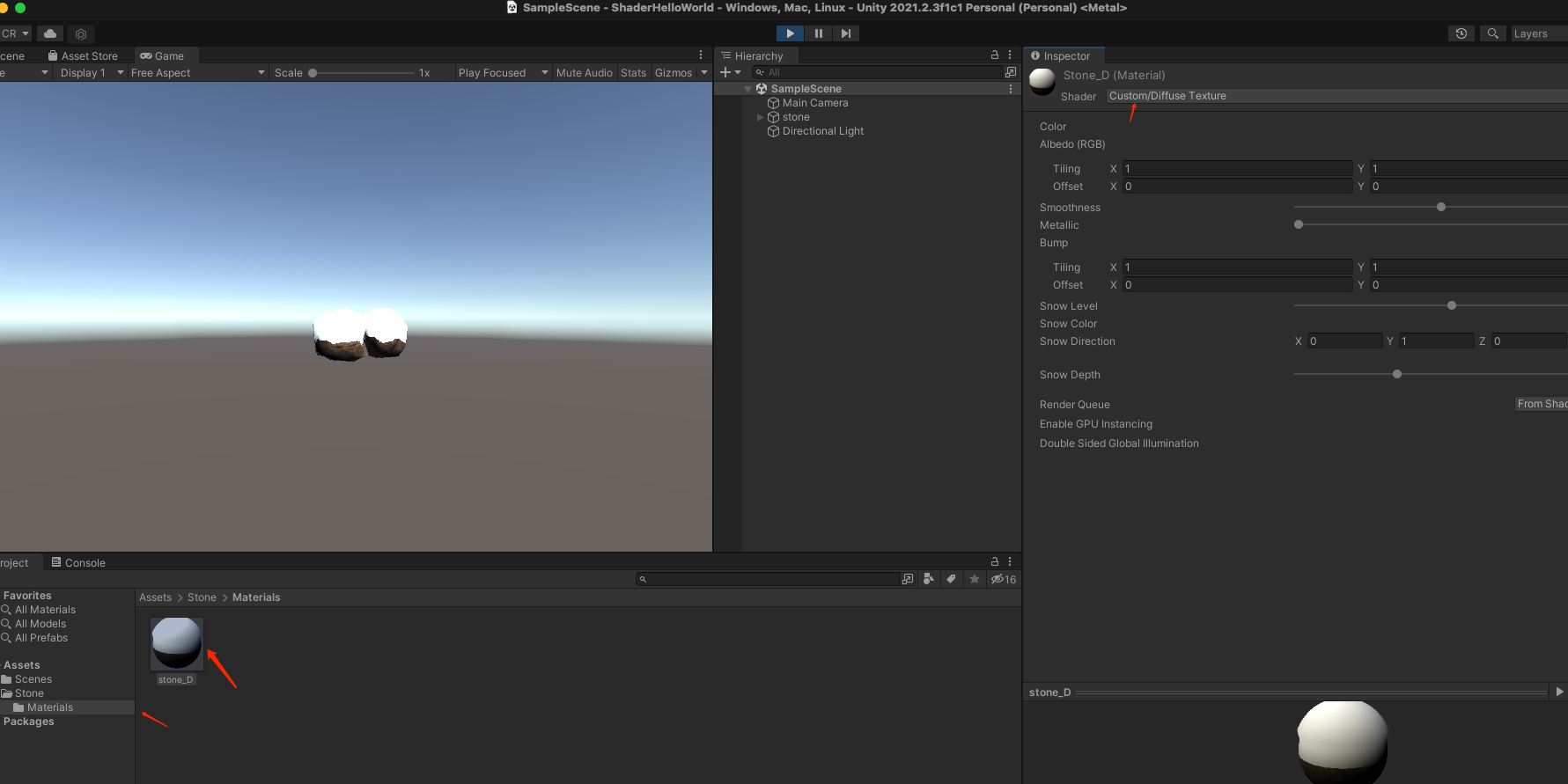shader初尝试 | 给石头覆盖一层雪景(Hello World)
给石头覆盖一层雪景
资源准备
- 石头模型
- Unity2021.2.3f1c1
- Mac & Windows
在Unity中创建一个项目,导入石头模型,下面就开始利用shader给石头做一个雪景覆盖.
实现效果
开始代码
我在代码中标注了1,2,3,4,5
代码
// Upgrade NOTE: replaced '_Object2World' with 'unity_ObjectToWorld'
Shader "Custom/Diffuse Texture"
{
Properties
{
_Color ("Color", Color) = (1,1,1,1)
_MainTex ("Albedo (RGB)", 2D) = "white" {}
_Glossiness ("Smoothness", Range(0,1)) = 0.5
_Metallic ("Metallic", Range(0,1)) = 0.0
//1
_Bump("Bump", 2D) = "bump" {}
_Snow ("Snow Level", Range(0, 1)) = 0.1
_SnowColor ("Snow Color", Color) = (1.0, 1.0, 1.0, 1.0)
_SnowDirection ("Snow Direction", Vector) = (0, 1, 0)
_SnowDepth ("Snow Depth", Range(0, 0.3)) = 0.1
}
SubShader
{
Tags { "RenderType"="Opaque" }
LOD 200
CGPROGRAM
// Physically based Standard lighting model, and enable shadows on all light types
#pragma surface surf CustomDiffuse vertex:vert
// Use shader model 3.0 target, to get nicer looking lighting
#pragma target 3.0
sampler2D _MainTex;
//2
sampler2D _Bump;
float _Snow;
float4 _SnowColor;
float4 _SnowDirection;
float _SnowDepth;
struct Input
{
float2 uv_MainTex;
//3
float2 uv_Bump;
float3 worldNormal; INTERNAL_DATA
};
half _Glossiness;
half _Metallic;
fixed4 _Color;
// Add instancing support for this shader. You need to check 'Enable Instancing' on materials that use the shader.
// See https://docs.unity3d.com/Manual/GPUInstancing.html for more information about instancing.
// #pragma instancing_options assumeuniformscaling
UNITY_INSTANCING_BUFFER_START(Props)
// put more per-instance properties here
UNITY_INSTANCING_BUFFER_END(Props)
void surf (Input IN, inout SurfaceOutput o)
{
// Albedo comes from a texture tinted by color
fixed4 c = tex2D (_MainTex, IN.uv_MainTex) * _Color;
//4
o.Normal = UnpackNormal(tex2D(_Bump, IN.uv_Bump));
if (dot(WorldNormalVector(IN, o.Normal), _SnowDirection.xyz) > lerp(1, -1, _Snow))
{
o.Albedo = _SnowColor.rgb;
}
else
{
o.Albedo = c.rgb;
}
o.Alpha = c.a;
}
inline float4 LightingCustomDiffuse (SurfaceOutput s, fixed3 lightDir, fixed atten)
{
float difLight = dot(s.Normal, lightDir);
float hLambert = difLight * 0.5 + 0.5;
float4 col;
col.rgb = s.Albedo * _LightColor0.rgb * (difLight * atten * 2);
col.a = s.Alpha;
return col;
}
//5
void vert(inout appdata_full v)
{
float4 sn = mul(transpose(unity_ObjectToWorld), _SnowDirection);
if (dot(v.normal, sn.xyz) >= lerp(1, -1, (_Snow * 2)/ 3))
{
v.vertex.xyz += (sn.xyz + v.normal) * _SnowDepth * _Snow;
}
}
ENDCG
}
FallBack "Diffuse"
}
声明并加入一个显示名称为Bump的贴图,用于放置法线图
为了能够在CG程序中使用这张贴图,必须加入一个sample,希望你还记得~
获取Bump的uv信息作为输入
从法线图中提取法线信息,并将其赋予相应点的输出的Normal属性。UnpackNormal是定义在UnityCG.cginc文件中的方法,这个文件中包含了一系列常用的CG变量以及方法。UnpackNormal接受一个fixed4的输入,并将其转换为所对应的法线值(fixed3)。在解包得到这个值之后,将其赋给输出的Normal,就可以参与到光线运算中完成接下来的渲染工作了。
更改顶点模型。
- #pragma surface surf CustomDiffuse vertex:vert
- 对应的函数是
void vert(inout appdata_full v)
关联材质与自己写的shader,作为初学者,我一度找不到关联材质与shader的地方, 下图是我做的笔记,方便后来人快速找到关联地:

总结
跟着教程走完整个流程, 当调整Snow Level这个参数的大小,石头上的雪景也跟着变换时,心里是非常有成就感的,这就是shader的魅力,感谢作者提供的教程。 下面我准备系统性的学习shader + 计算机图形学,从《Unity Shader入门精要》开始
到时候再回过头来看看这篇笔记中我不理解的点。比如光照模型、shader的编程语法问题和顶点着色器和表面着色器的区别。
学习参考
--完--
- 原文作者: 留白
- 原文链接: https://zfunnily.github.io/2022/04/shaderhelloworld/
- 更新时间:2024-04-16 01:01:05
- 本文声明:转载请标记原文作者及链接

